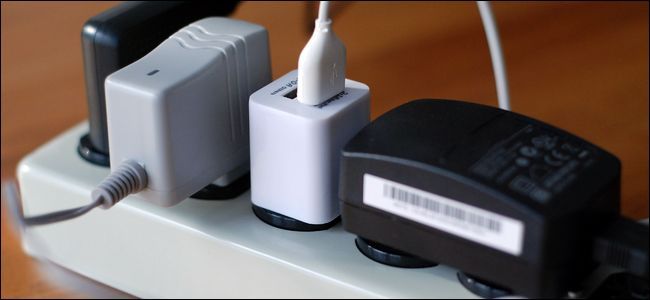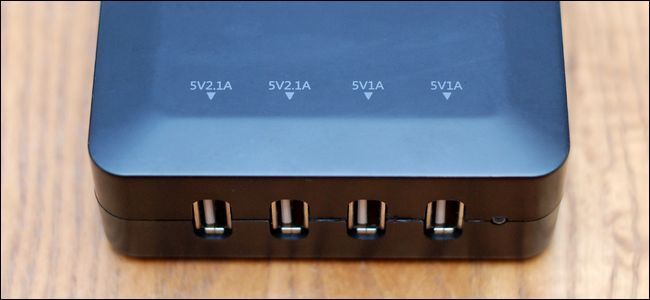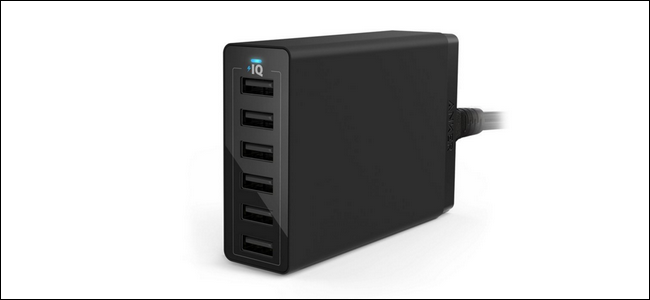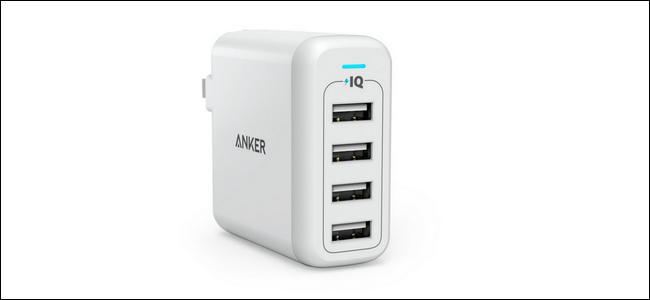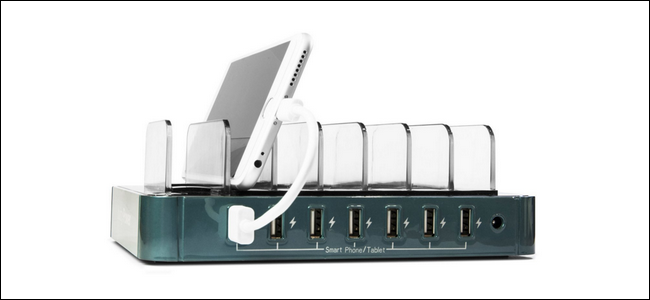Smartphones, smart watches, tablets, fitness trackers, and all our other gadgets leave us burdened with multiple chargers and so much clutter. Liberate your outlets and charge all your devices with a single plug.
We all have multiple devices to charge every day, and that number is only going up. If you use the individual charger that comes with each device, you'll quickly gobble up multiple outlets in your quest to charge your personal phone, work phone, tablet, and other devices.
You could just get a power strip and plug all the individual chargers into that strip, but that solution is ugly, bulky, and inefficient, as each individual charger is running a separate AC to DC transformer.
A far more elegant solution that cuts down on the clutter, reduces your outlet needs to a single outlet, and is more energy efficient, is to use a USB charging station (pictured at the top of this article). With a charging station, you use one power outlet for one transformer which in turn provides power to four or more USB ports.
Many people are missing out on the benefits of using a charging station because when they think "charging station", they think of a big bulky rack-like device that looks more at home in a school computer lab than on their nightstand. While you could certainly get one of those for your home if you wanted to prop up, say, all the family's tablets in one organized place, the majority of people will be best served by purchasing a simple multi-port USB charging station.
Not all USB charging stations are created equal, though. So let's take a look at features to consider when purchasing a USB charging station.
How to Select the Right USB Charging Station
Searching for the right charging station can get overwhelming pretty quickly, as there are hundreds of them on the market in every possible configuration and at a wide range of price points. To help you decide between particular models, we've outlined key features to look for when shopping, but if you're in a hurry and just want to buy one right this second, you can always jump down to the section with our recommendations.
UL Certification
Over the last few years, there have been a rash of extremely low quality and uncertified chargers on the market. Not only are these chargers not particularly energy efficient, but they can potentially damage your devices and even create fire hazards.
Safety certification by the Underwriters Laboratory isn't exactly glamorous, but considering that many people use their chargers in their bedrooms, safety is of paramount importance. The last thing you want is for the charger under your nightstand to burst into flames and set your bed ablaze.
If a device isn't UL certified, then no questions asked--don't buy it. Saving $10 on a charger isn't worth the risk of a house fire.
Form Factor
USB charging stations come in three forms factors: wall chargers, corded hubs, and organizers. Which form factor you select is generally a matter of personal preference, combined with consideration for where you will be using it.
Wall chargers (shown to the left in the image below) are all-in-one models that plug directly into the wall like a giant transformer and have no extension cord of any sort. The box, if you will, goes right against the outlet and all the USB cords for your devices are inserted directly into the outlet-attached box.
Corded chargers (above center) are essentially identical to the wall chargers, with the distinction that they have a power cord tether to the outlet. This has a distinct advantage in that you gain a few extra feet of movement and the plug can be used in small spaces where a larger wall-mounted charger would be impractical or impossible. For example, we use a corded USB charger in our bedroom where it is plugged in behind the bed with the USB cables routed to both night stands. Because of the spacing and alignment of the bed frame, it would be impossible to use a wall-mounted charger but a corded charger can be plugged in just like a lamp with plenty of room to spare.
Organizer style charging stations (above right) are bulkier, but offer racks, slots, or caddies for your equipment. We generally shy away from these products, simply because the markup is generally anywhere from 50-100% over the cost of a similar charger, just for a few plastic organizers attached. If we were really bent on having some sort of rack-based organization for our charging station, we'd probably just buy a desk organizer to use along side the regular charger. You can find desk organizers/sorters and letter trays for less than $10 in a wide array of materials.
Number of Ports
You may think this step is simple: you need enough ports to charge all your devices. But don't think "Alright, I have one smartphone, one tablet, and one ebook reader, therefore I need three ports." The cost difference between models is trivial when priced on per-port basis; give yourself room to expand. If the goal is to cut down on clutter and only use one outlet, then you need to buy with an eye on future use. So buy a charger with a few more ports than you currently need.
Port Amperage
Just like external battery packs, the USB ports on your charging station will have different amperage outputs, which can make a significant difference in how fast your devices charge.
Standard USB amperage outputs are 1A, 2.1A, and 2.4A. All USB devices will charge on the lower amperage ports, but devices with large batteries--like newer tablets and smartphones--will take a long time to fully recharge on lower amperage ports. So for those devices, it's better to have some higher amperage ports to charge them.
You don't necessarily need to buy a USB charging station that has all high-amperage ports, but you definitely shouldn't buy a charger with only 1A ports. When comparing two chargers, if all other features are equal and the prices are more or less comparable, always go with the charger with the higher number of 2.1A and/or 2.4A ports. Devices are getting more power hungry over time, and there is little sense in not spending a few bucks to extend the lifespan of your charger.
Specialty Charging Features
The above features are far more important than any specialty features a charger may come with. But, in some cases, extra features are still worth noting. Some chargers, for example, have ports with specialty circuits to take advantage of various "fast charge" technology, like Qualcomm's "Quick Charge" system for Android devices. Others may include wireless charging alongside its regular bank of USB ports, so you can set your wireless-charging enabled device right on top.
For more users there is no point in picking up a charging station with device-specific features like propriety fast charging, but if you have a device that supports it you may consider the premium worth it.
Our Recommendations
If you're thinking "That's great guys, but seriously just tell me which one to buy", then read on. If you're totally on board with the idea of swapping out your mass of individual chargers for a more streamlined system, but you're not interested in comparison shopping for yourself, here are some rock-solid models we'd recommend.
While we can't recommend the perfect fit for every situation, the following three recommendations are definitely best in class for their particular form factors.
The Anker Power Port 6 ($32) is compact (a little bigger than a deck of cards), with adjustable ports that automatically increase voltage up to 2.4A when necessary to deliver the fastest charge. It includes a 5 foot power cord, so you can easily place it right where you want, especially when bulkier outlet-mounted options won't fit. It also comes highly recommended: over 3,000 Amazon reviews and a solid 5 star rating.
The Anker Power Port 4 ($24) offers the wall charger form factor with two fewer ports than our previous recommendation, but the same circuitry that offers intelligent up-to-2.4A charging on all four ports and the same overall high quality. Like the bigger Power Port 6, it has sterling reviews (700+ reviews with an average of 5 stars).
Although we expressed our general dislike of organizer-style charging stations already, there are a few good values if you dig. The Juicy Power 7-Port Charging Station ($47) sports UL safety certification (which is strangely missing from way too many organizer-style stations), 7 ports all capable of 2.4A output, and a compact enough design that if even you abandon the organizer aspect of the charger, you're not stuck with some monstrosity on your desk or nightstand.
Armed with a little knowledge you can find the perfect charger for your needs and, in the process, banish that power-strip worth of individual chargers cluttering up your kitchen counter or bedroom floor.


